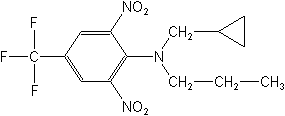|
Return to Profluralin
Adverse Effects
ACTIVITY:
Herbicide
(2,6-Dinitroaniline)
Note:
WHO:
Believed to be obsolete or discontinued for use as pesticides.
CAS Name:
N-(cyclopropylmethyl)-2,6-dinitro-N-propyl-4-(trifluoromethyl)benzenamine
Structure:

| Adverse
Effects:
Carcinogen
Liver |
| Environmental
Effects:
Toxic
to Honey Bees
Very
High Bioconcentration in Aquatic Organisms
Persistent
in soil |
Regulatory
Information
(only comprehensive for the US) |
| US
EPA Registered: |
No |
| US
EPA PC Code: |
106601
(Old US EPA PC Code: 304300) |
| California
Chemical Code |
1897
|
| US
Tolerances: |
Revoked |
| FDA
LMS Code: |
A53 |
US
EPA Permit Date
and Registrant: |
1973,
Ciba-Geigy |
| Other
Information |
| Molecular
Formula: |
C14H16
F3 N3O4 |
| Manufacturers: |
Syngenta |
| Other
Names: |
Pregard
Tolban
CGA 10832
ER-5461 |
| Former
Manufacture site: |
US:
[Ciba-Geigy Corp] McIntosh, Ala 36553. |
| Of
special interest: |
| PAN
Data |
| TOXNET
profile from Hazardous Substances Data Bank |
| Believed
to be obsolete or discontinued for use as pesticides.
WHO Recommended Classification
of Pesticides by Hazard and Guidelines to Classification 2000-2002.
Table 6. Active ingredients not included
in the Classification and believed to be obsolete or discontinued
for use as pesticides, p 37. |
March
2000 - Cenex Supply and Marketing, Inc. (CSMI) in Quincy, Grant
County, Washington, operated a liquid fertilizer and soil fumigant
storage and distribution facility. Seious contamination resulted
from the landspreading of pesticide sediment sludges on agricultural
land. Among the many pesticides found in soil samples, three
herbicides (trifluralin,
vernolate, and ethalfluralin),
one insecticide (chlorpyrifos), one pesticide (disulfoton),
and three metals (chromium, beryllium, and cadmium) exceeded
one or more health-based comparison values in CSMI soil.
Profluralin
was also found in soil samples. The population of Quincy is
3,715. This report characterizes the community's concerns about
excess cancer and disease rates, very rare abnormalities such
as Rubinstein-Taybi
Syndrome, and ill health as not "unusual"
- a typical ATSDR-explantion handed out to very sick communities
-- organofluorine pesticides highlighted
in red. |
| March
1985 - Herbicide
Profile (Tolban) - Pesticide Management
Education Program (PMEP) at Cornell Univeristy |
| October
2001 -
Glossary of Pesticide Chemicals.
A listing of pesticides subject to analysis
of residues in foods and feeds by the US Food and Drug Administration. |
| April
2000 - Food
and Drug Administration Pesticide Residue Monitoring.
- Table 3. Pesticides detectable by methods used in 1999 regulatory
monitoring. |
| US
Federal Register |
| 1992 |
The
EPA has proposed to revoke the tolerances (Tolban) for residues
of profluralin in or on ALFALFA; COTTONSEED; EGGS; MILK,
MEAT, FAT, and MEAT BY-PRODUCTS of CATTLE, GOATS, HOGS, HORSES,
POULTRY, and SHEEP; SAFFLOWER (seed); SEED and POD VEGETABLES
(dry, succulent, fodder and forage); SOYBEAN (hay); and SUNFLOWER
(seed). This herbicide was cancelled by the USEPA in April
of 1984. Note: The Fed. Reg. does not have online access to
1992 documents. This EPA notice is from the PMEP at Cornell
University. |
Product
Name:
TOLBAN
4E HERBICIDE
US EPA Registration Number: 100-
523-AA
Status:
Inactive: 13-FEB-85
Ingredients
found:
1.9% of PROFLURALIN, OTHER RELATED
43.6% of PROFLURALIN
54.5% of INERT INGREDIENTS
Use:
ALFALFA
(FORAGE - FODDER) (ALFALFA HAY) (23001)
BEANS (ALL OR UNSPEC) (28001)
COTTON (ALL OR UNSPEC) (28007)
COTTON, GENERAL (29121)
LEGUMES & OTHER NONGRASS CROPS FOR FORAGE-FODDER (23000)
OKRA (GUMBO) (15015)
PEAS (ALL OR UNSPEC) (ALL OF UNSPEC) (28016)
PEAS, GENERAL (29127)
SAFFLOWER (ALL OR UNSPEC) (28076)
SAFFLOWER, GENERAL (29129)
SORGHUM (ALL OR UNSPEC) (28019)
SORGHUM/MILO GENERAL (29131)
SOYBEANS (ALL OR UNSPEC) (28023)
SUGARBEET (ALL OR UNSPEC) (28020)
SUGARBEET, GENERAL (29135)
SUNFLOWER (ALL OR UNSPEC) (28021)
SUNFLOWER, GENERAL (29133)
|
|